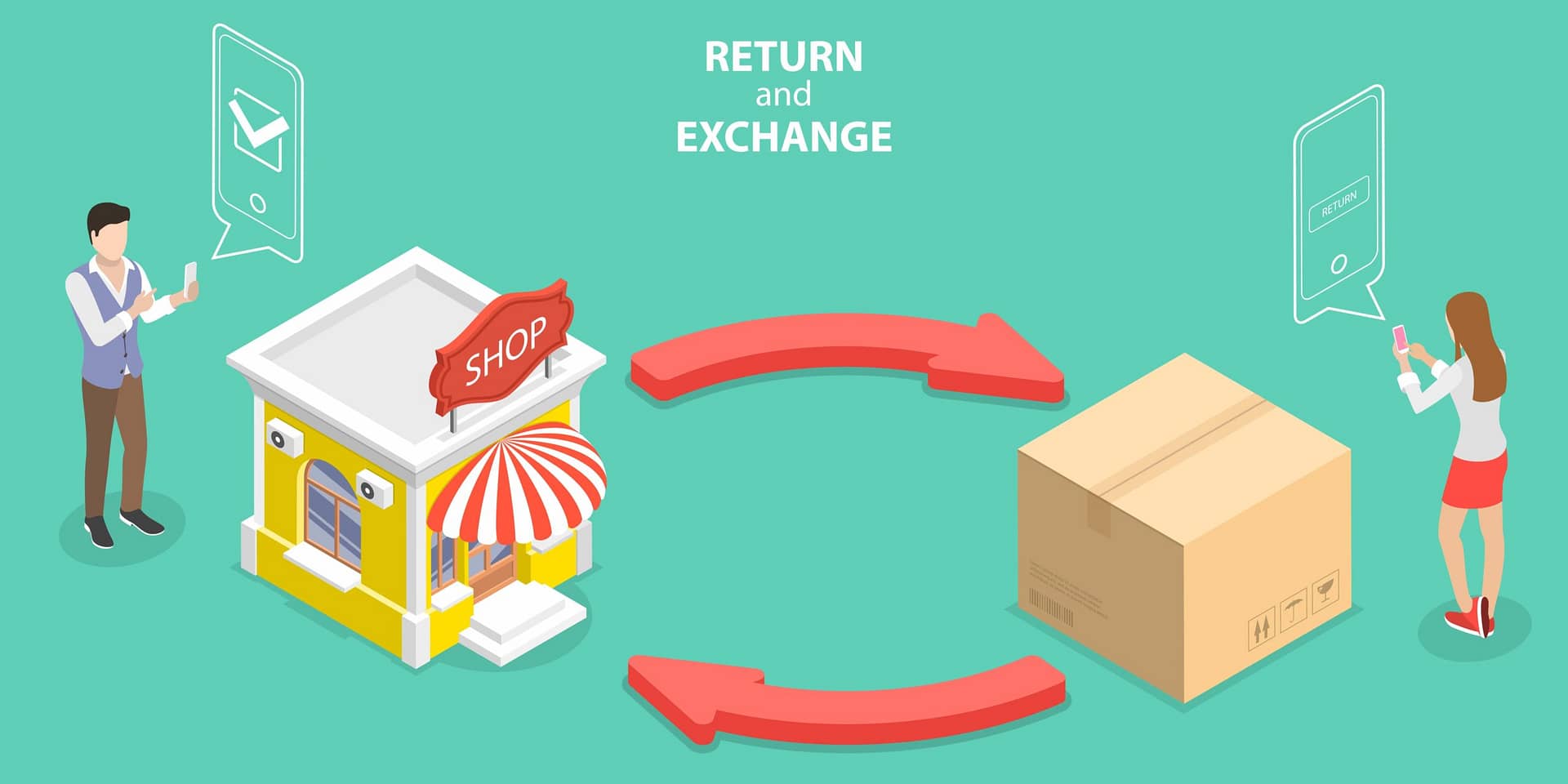Returnalytics: What is Bracketing and How Can You Manage Serial Returners?
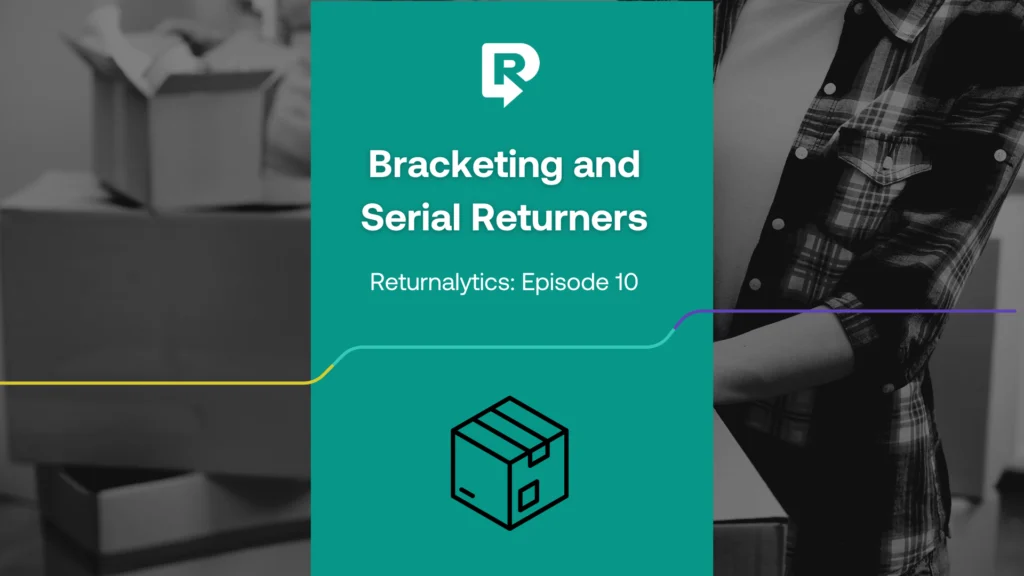
About the Episode
The Returnalytics podcast discusses the latest retail trends, technology, and best practices for managing an ecommerce business and retail returns.
In this episode, we tackle a topic that comes up frequently when speaking to overwhelmed ecommerce merchants:
The Returns Hierarchy of Needs
The Returns Hierarchy of Needs is something we created based off Maslow’s Hierarchy of needs. Maslow’s Hierarchy of needs talks about the stages of growth in humans. The hierarchy is split between deficiency needs and growth needs.
The Returns Hierarchy of Needs was created to help retailers identify where they are in their journey based off three stages. Automation, Visibility, and Optimization.
Listen in as we discuss what the Returns Hierarchy of Needs is and help you identify where your business lies within these three stages.
Listen to the full episode on Spotify or get the summary below.
About the Speakers
Travis Farey
Travis is a Product Marketing Specialist at ReturnLogic. Travis graduated from Shippensburg University with a Bachelor of Science in Supply Chain Management & Marketing. Travis has been working for ReturnLogic for over 2 years and started out as a Customer Support Specialist before working his way into Product Marketing.
David Gonzalez
David is a Senior Growth Manager at ReturnLogic, previously working as a Product Marketing Manager. David has prior startup experience formerly working at Drip and WhenIWork. He works closely with the Product, Sales, and Marketing teams at ReturnLogic to act as the voice of the customer and how to understand the ecommerce market.
Episode Transcription
Travis Farey – 0:00
Hi, I’m Travis Farey and this is the returns management podcast by ReturnLogic; a show where we connect ecommerce store owners together through casual discussion and examine current myths and trends to keep you up to date on everything happening in the ecommerce world.
On today’s episode, we’re covering the Returns Hierarchy of Needs. We’ll first start by touching on Maslow’s hierarchy of needs and how we’ve used that to create something we call the Returns Hierarchy of Needs. We’ll discuss the three stages in the hierarchy including automation, visibility, and optimization, and much more on today’s episode. My name is Travis Farey and I’m a Product Marketing Specialist here at ReturnLogic and today, I’m joined by none other than David Gonzalez, Senior Growth Marketer here at ReturnLogic.
So, without further, do let’s get this show started.
David Gonzalez – 1:12
So, Travis I was talking to a merchant the other day, and she was describing how returns impacted her store over time. It was really interesting because I’ve heard the same story so many times and brands go through this similar progression. I’m curious if our listeners can relate here.
So, when she was first starting out, she said she was excited to get that first sale. Get sales going. Then all of the sudden she got her first return.
She told me she was a little off put by it. She felt like she did something wrong. And as her sales grew, she started to get more and more returns.
So, she started recording these returns on a spreadsheet. Then ultimately hired her first person to help handle customers and manage returns.
So, once she had some help, she said she could focus more on growing sales. Which she did. Really really quickly. But then her rep just couldn’t keep up. They were swamped. So, she had to hire some more people so that she could continue to grow. Right?
And she actually didn’t start out with us. She started out with an app called ReturnMagic, which sunset I believe about a month or two ago. But eventually it just wasn’t able to solve all of her problems and scale with her. Her returns problem just kept getting bigger.
She finally got to this place where she grew enough where she could keep her own inventory in a warehouse. She had a warehouse and an ops team. But after a few months, her warehouse team just couldn’t keep track of everything. They felt out of the loop. They felt disconnected. So, shoppers just weren’t getting their items on time. And then all of the sudden she was just stuck.
So, after all that hard work to scale to a certain point, her returns problem crept up and she said it was like a nightmare. So, finally she did some shopping around. She talked to a handful or returns management companies. She said she had to try out a few, and ultimately, she connected with us.
But I hear stories similar to this all the time. At some point in companies’ growth journey, returns get too tough to deal with, and they put a chokehold on growth.
Travis Farey – 3:08
Alright. Everybody please give David a round of applause for the Ted talk, just messing with you. But all jokes aside, are we talking about Liz here?
David Gonzalez – 3:16
Yeah. She’s great. I feel her therapists sometimes when we chat about returns.
Travis Farey – 3:21
Oh yeah, she loves to vent about returns. And I love to listen. But anyways, I definitely hear you and I’ve heard this same story myself many times.
It’s like a natural progression as companies scale. Companies have to get better and better at handling returns and evolve or else they’re momentum just stalls.
David Gonzalez – 3:42
Exactly.
Travis Farey – 3:44
Hey David, do you remember anything from your Psych 101 class?
David Gonzalez – 3:48
Uh, not as well as I should. But I know that Freud guy talks about childhoods.
Travis Farey – 3:51
Well, unfortunately, we’re not here to discuss your childhood trauma unless that involves Maslow and his hierarchy of needs. Do you remember anything about that?
David Gonzalez – 4:01
Remind me?
Travis Farey – 4:02
Yeah, no problem. So, Maslow’s hierarchy of needs, talks about the stages of growth in humans, which honestly reminds me a lot of companies and how they grow.
The hierarchy is split between deficiency needs and growth needs, which ultimately lead to transcendence or enlightenment.
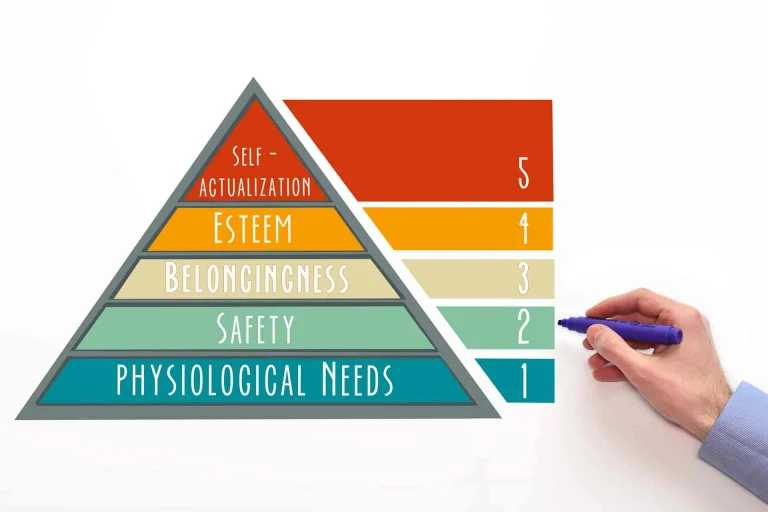
David Gonzalez – 4:21
Man returns enlightenment. Well, if there’s this enlightenment stage, who is an enlightened returns company?
Travis Farey – 4:28
I know this is going to be a big shocker here. But the first one that comes to mind for me is Amazon.
David Gonzalez – 4:33
Yup. Saw that coming
Travis Farey – 4:35
Yeah, of course. I mean, Amazon’s, definitely a company to keep an eye on, and they always seem to be ahead of the game, but let’s talk more about managing returns and how that’s a progression. And let’s define some of those stages throughout this progression.
David Gonzalez – 4:50
For sure. Let me just Google Maslow’s hierarchy of needs. Quick. Alright. So, the first stages are physiological needs and safety needs. So those needs have to be satisfied before you can level up or progress.
So, when it comes to returns, the first stage has got to be giving your shoppers a returns portal and some sort of level of automation, being able to automatically approve refunds, allowing exchanges, issuing store credit without having to talk to anyone. Just saves your support team. I’d say that usually happens around like 50 returns per month maybe more.
Travis Farey – 5:25
Yeah, I definitely agree there and that covers the part of the returns hierarchy that we call automation.
I’d say the next step is the warehouse and operations team phase. We call this the visibility stage.
Here, your goal is knowing what’s going on with every return and maintaining accurate inventory numbers. That visibility is going to be huge. If you can get your support team in step with your warehouse team, you can create a well-oiled returns machine.
David Gonzalez – 5:56
Yeah. Good call out. And so now that I’ve actually Googled what those different Maslow, hierarchy of needs stages are. Is that visibility stage like the love, belonging, and esteem stage? Those are basically equivalent to that visibility stage when it comes to returns.
Travis Farey – 6:10
Yup. Exactly. That’s a great way to look at it.
David Gonzalez – 6:12
So, what’s the last stage then? When does that happen?
Travis Farey – 6:15
Yeah. So the last stage is Maslow’s enlightenment stage or what we call optimization in the returns hierarchy of needs. This usually happens when retailers hit around 150 returns per month. I have honestly no idea why it’s that number but it’s almost like an invisible barrier.
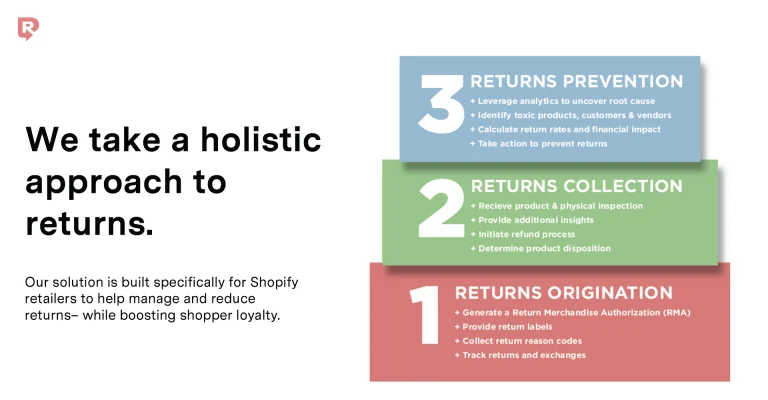
David Gonzalez – 6:33
Why optimization?
Travis Farey – 6:35
Yeah, great question. So, after you’ve solved the automation and the visibility stages, the last part of the equation is putting together a few key pieces. The first piece is figuring out why returns are happening. The second piece is calculating how much returns are costing you. And the third and final piece is figuring out where you should be focusing your time and dollars.
David Gonzalez – 7:01
Got it. So, you basically get some sort of analytics that help, you know, help, you know, which levers to pull on.
Travis Farey – 7:07
Exactly. So, you can determine where you’re choke points are, you know, when and how to improve your products. And overall, you can consistently improve on your strategy and use returns data to improve the shopper experience, improve operational efficiency and then ultimately grow your profits.
David Gonzalez – 7:26
So, if I understand that correctly, you’re basically using your returns data to improve your returns processes and therefore reducing your return rates, making sure that you can scale your operations which ultimately grows your profits. Is that fair enough to say?
Travis Farey – 7:42
Yeah. So basically, once you can automate things for your support team and you can get your warehouse team to know the status and condition of each return, you can then dive into the data to continuously improve your products over time.
I truly believe that anyone can be as good as Amazon at managing returns and possibly even better.
David Gonzalez – 8:04
That’s a bold statement.
Travis Farey – 8:05
You know that it is David, but I stand behind it. I see more and more companies who adopt this same philosophy focusing on scaling their operations and optimizing the reverse supply chain. For instance, I was talking to a retailer the other day who looks at returns data to determine where he should put marketing dollars and won’t even calculate return on ad spend without including returns data.
There’s just so much opportunity out there.
David Gonzalez – 8:35
Gotta say, I’m loving the optimism.
Travis Farey – 8:37
Well, we all should be optimistic because at the end of the day if you can make your returns process as easy as possible for your team that’s what’s really going to lead to growth and also lead you to happier shoppers.
David Gonzalez – 8:50
Interesting. Well, what about focusing on driving exchanges?
Travis Farey – 8:53
Yeah, that’s a good tactic. But ultimately, there’s a reason that Bezos focuses on operations and profits, as he says, “your margin is my opportunity”.
David Gonzalez – 9:04
Yeah, I’d say he knows a thing or two about growing an ecommerce company.
Travis Farey – 9:07
Yeah. Well, definitely more than you and I.
David Gonzalez – 9:10
Travis, I don’t even remember my Psych 101 class. Of course, he knows more than me.
Travis Farey – 9:14
Well, we can’t all have the minds of Jeff Bezos, but using the Returns Hierarchy of Needs will definitely get us a step closer.
Let’s run it back one more time for our listeners.
A retailer journey or evolution can be broken down into three stages. The first stage is going from a manual process to a fully automated process. The second stage is looping in your warehouse, an operations teams to gain more visibility. And then the last stage is the optimization piece which retailers can use to scale to new heights.
And when you put it altogether, you have automation, visibility, and optimization.
David Gonzalez – 9:54
The Returns Hierarchy of Needs
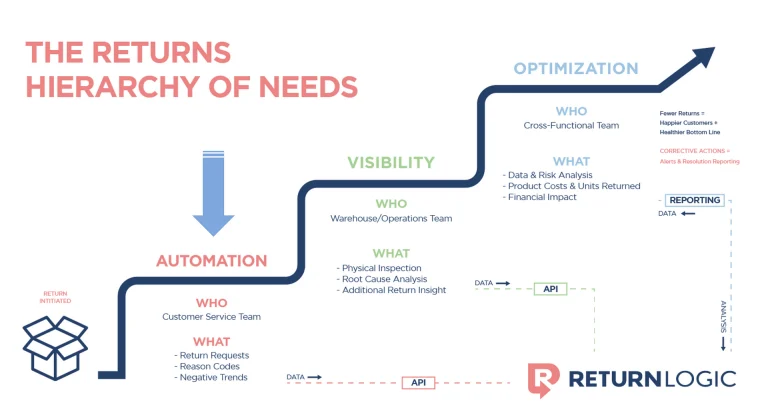
Travis Farey – 9:57
Exactly. Throw a trademark on it.
Well, that’s all we have for today, folks. I want to give a special thanks as always to David for joining me on today’s episode and we’ll see you guys on the next one.
Travis Farey – 10:15
Thanks for listening. Catch another episode, learn more at returnlogic.com, and find us on YouTube and I’ll see you back here on the returns management podcast.
